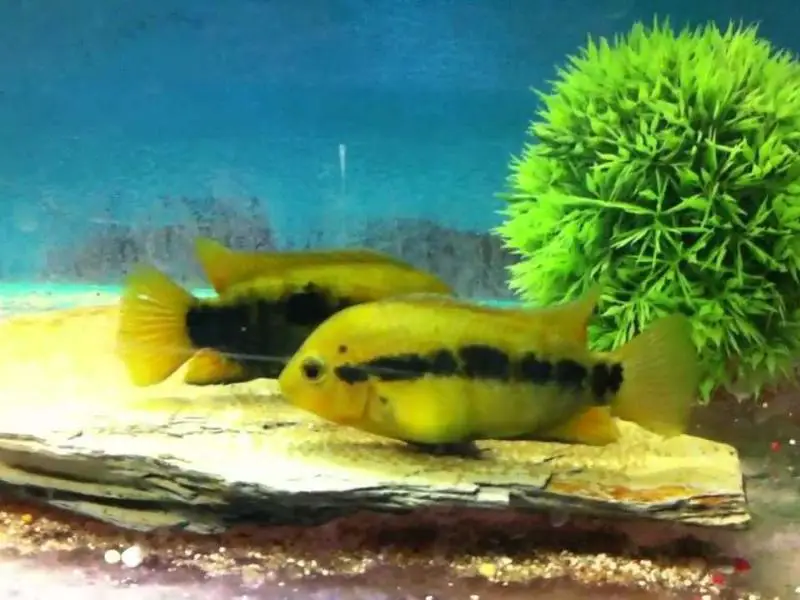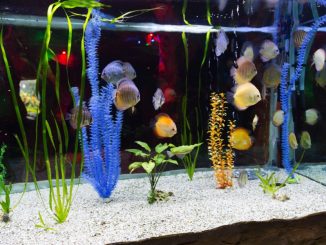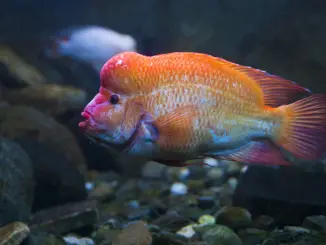
The rainbow cichlid is a freshwater species from the larger fish family of cichlids. Rainbow cichlids are popular among aquarists thanks to their beautiful coloration and adaptability. They are perfect beginner fish.
The rainbow cichlid is a great addition to a tank with other Central and South American aquarium fish. Keep rainbow cichlids with fish that require similar water conditions.
Rainbow cichlids are peaceful and adaptable, and their beautiful colors will stand out in any community tank.
TABLE OF CONTENTS
Rainbow Cichlid Facts & Overview

| Category | Rating |
| Care Level | Easy |
| Temperament | Peaceful |
| Color | Muddy brown, tan, yellow, gold |
| Lifespan | ~9 years |
| Size | 3–5 inches |
| Diet | Omnivore |
| Family | Cichlidae |
| Minimum Tank Size | 20 gallons |
| Tank Setup | Freshwater, plants, caves |
| Compatibility | Peaceful community fish |
The rainbow cichlid is part of the large family of cichlids. The cichlid family includes over 1,600 species of fish. More new species are discovered every year. The cichlid family represents species of various colors, shapes, and sizes. Cichlids are medium-sized and have elongated bodies. The single nostrils on either side of the fish’s forehead is a common species feature.
Rainbow cichlids are one of the smallest fish in the cichlid family. Their scientific name is Herotilapia multispinosa, and they belong to the Cichlasomatinae subfamily of cichlids. They were discovered in 1867. The fish use their tricuspid teeth to feed on algae.
These fish are found in the rivers and lakes of Central America. Rainbow cichlids are native to Honduras, Nicaragua, and Costa Rica. These fish thrive in the Patuca River in Honduras and the Matina River in Costa Rica. Rainbow cichlids have been introduced to a hot spring in Hungary in the spa town of Heviz.
The rainbow cichlid is found in shallow muddy waters with rich vegetation. This fish has adapted to feeding on algae with its specialized teeth. They are common in the wild.
Healthy fish have a lifespan of 7 to 9 years. Aquarists can find rainbow cichlids easily in aquarium fish stores. These fish cost between $10 and $30 and will happily coexist in a group or a pair of the same species.
Appearance & Behavior

The rainbow cichlid is a colorful fish. The fish’s base color is muddy brown or yellow with darker spots forming a horizontal bar along the fish. The spots can also appear larger and shade the bottom half of the fish.
Rainbow cichlids have the ability to change colors depending on their mood or stage of spawning. They can change color in a few seconds, with shades ranging between yellow and golden to dark brown.
The rainbow cichlid has an elongated body with pointed dorsal fins. Rainbow cichlid living in an aquarium will grow between three and five inches long. Wild fish can grow up to seven inches long.
Male and female rainbow cichlids look similar. Males have long bodies, bright coloration, and pointed fins. Females have round bodies and rounded fins. Female fish are also larger than male fish.
Typical Behavior
Rainbow cichlids are peaceful community fish that get along well with other non-aggressive fish of similar size. These fish exist in nuclear families, with older siblings taking care of the younger ones. Rainbow cichlids are also easy to breed at home.
These fish are active and swim in the middle of the tank. They hide and change to a paler color when the fish senses danger. This behavior is why rainbow cichlids require a variety of caves and rocks to hide in moments of perceived threat.
These fish are active during the day. Rainbow cichlids require soft aquarium lighting similar to the light conditions in their natural habitat. One of the cichlids’ unique behaviors is “smelling” the water. Rainbow cichlids use their nostrils to suck the water in and expel it back to the tank.
The rainbow cichlid can produce sounds underwater. Experts believed that this fish uses its swim bladder to emit various sounds during spawning.
Rainbow Cichlid Care
The rainbow cichlid is easy to care for. This fish is ideal for beginners and experienced fish keepers. The fish’s compact size and ability to adapt to different environments make it a good fish for new aquarists.
Rainbow cichlids need clean water. Performing regular water changes is important. The fish also thrives in tank conditions similar to its natural habitat. The rainbow cichlid has flexible water temperatures and acidity requirements.
These fish are omnivorous, and providing them with a balanced diet is simple. Rainbow cichlids can feed on a range of fish foods, including frozen bloodworms, vegetable, and meat flakes, as well as plankton.
Rainbow cichlids are generally healthy and resilient. They are prone to some common diseases, like Ich or parasitic infestations, all of which can be cured quite easily.
Habitat and Tank Requirements

The natural habitat of the rainbow cichlid is represented by the muddy and slow-running rivers, lakes, or even swamps, of Central America. Rainbow cichlids live in muddy, slow-moving rivers, lakes, and swamps in Central America. The climate in their region of origin is hot, which makes the fish resistant to high water temperatures.
Keep the tank environment similar to the rainbow cichlids’ natural habitat. These fish need plenty of natural plants, warm water, and a fine substrate to thrive. These fish can live in a small tank. A 20-gallon tank is an appropriate size for a rainbow cichlid pair. They will also do well in large community tanks.
Rainbow cichlids enjoy warm water temperatures ranging from 78°F to 82°F. These fish can adapt to slightly warmer temperatures if necessary. They prefer slower water in an aquarium, which is why introducing an active water bubbler is not recommended.
Changing the water in the aquarium on a bi-weekly basis will maintain hygiene and keep the fish safe from disease. Add a good water filter to the tank to support the conditions in-between water changes.
Rainbow cichlids are used to rich vegetation in their natural habitat. Add a variety of plants to the tank. These fish do not damage the plants and enjoy swimming around and hiding amongst the foliage. Rainbow cichlids need lots of room to swim in, so aquascape the aquarium accordingly.
Tank Mates
The rainbow cichlid is a great community fish that gets along with a variety of other species. Rainbow cichlids can live on their own or in pairs.
This fish is compatible with a range of other tropical fish with a similar temperament. Catfish, tetras, and plecostomus are examples of appropriate rainbow cichlid tank mates. Rainbow cichlids are great tankmates for other varieties of cichlids. Rainbow cichlids should not share a tank with aggressive or large fish. Rainbow cichlids will become territorial at times. This behavior is common during spawning.
Rainbow cichlids should not be paired with fish that are significantly larger and more aggressive. Non-fish species such as shrimp and crabs shouldn’t be placed in a rainbow cichlid tank unless the aquarist is experienced.
Disease
Rainbow cichlids are generally healthy fish that are not prone to any rare diseases. They can suffer from common fish diseases if the conditions in the tank are not satisfactory.
Rainbow cichlids are prone to Ich. Ich appears as small white spots all over the fish’s body and is accompanied by atypical behaviors like loss of appetite and excessive hiding. Heating water in the tank to about 86ºF for three days will treat the infection without causing the fish discomfort.
Rainbow cichlids can also catch common parasites and bacterial infections in the tank. These are treated easily with antibiotics or frequent water changes. Quarantine new fish for three weeks to prevent contamination.
Diet and Feeding
In the wild, a major part of the rainbow cichlids’ diet is algae. Rainbow cichlids eat algae in the wild. These fish will eat smaller fish, insects, and microorganisms, so providing the rainbow cichlids with a balanced diet will keep them healthy.
Rainbow cichlids should feed on a variety of plant-based and animal-based foods, including frozen bloodworms, plankton, flakes, brine shrimp, and floating food sticks. Vitamins and supplements are beneficial to rainbow cichlids. Add supplements to the water regularly to keep the fish healthy.
Feed rainbow cichlids twice a day by putting small amounts of food into the aquarium. Experts suggest that a one-day pause in feedings weekly can be beneficial for the fish, as they tend to be eager eaters whenever fed.
Breeding

Breeding rainbow cichlids is easy for a beginner aquarist. These fish readily form pairs and build families that take care of each other.
Buy several young rainbow cichlids, place them in a tank together, and let them select their partners. Once the pairs are formed, condition them on a diet of frozen foods, like bloodworms, shrimp, and brine for a couple of weeks.
Place the pairs in a separate breeding tank once the fish are ready to begin the spawning process. If spawning takes place in a communal tank, the pairs can get aggressive defending the eggs.
The water temperature in the tank should be higher than normal at about 82°F during spawning, and the water pH should be around 7.0. Make sure to set up a smooth flat stone in the tank for the female to lay eggs on and decorate the tank with green plants to create a familiar environment for the rainbow cichlids.
Rainbow cichlids often change color during spawning. The female will lay eggs on a stone or other flat surface after the mating ritual. The number of eggs will vary between 300 and 1000. The parents take turns fanning the eggs for three days until the fry hatch.
Move the parents to a different area of the tank once the eggs hatch. Adult fish will eat the fry. Feed the fry with baby brine shrimp for the first week. Feed mature fry crushed fish food flakes.
Should You Get a Rainbow Cichlid for Your Aquarium?
Rainbow cichlids are a great addition to any tank and a perfect beginner fish for a novel aquarist. These fish will add beautiful golden colors to the aquarium and become a great company for other tropical fish in the tank.
Keep in mind that rainbow cichlids require enough space to swim freely and can be demanding for the level of hygiene in the tank. Their high adaptability and friendly nature make them highly desirable around tank owners around the world.








It seems as though the article is confusing Pelvicachromis pulcher (also called rainbow kribs) with rainbow cichlids (Herotilapia multispinosa). Some info (and the photos) pertain to the former and some (including the video) to the latter.
Hi Mark, thank you for noticing and pointing out that mix-up. I’ve updated the piece with the correct content and pictures.
-Robert